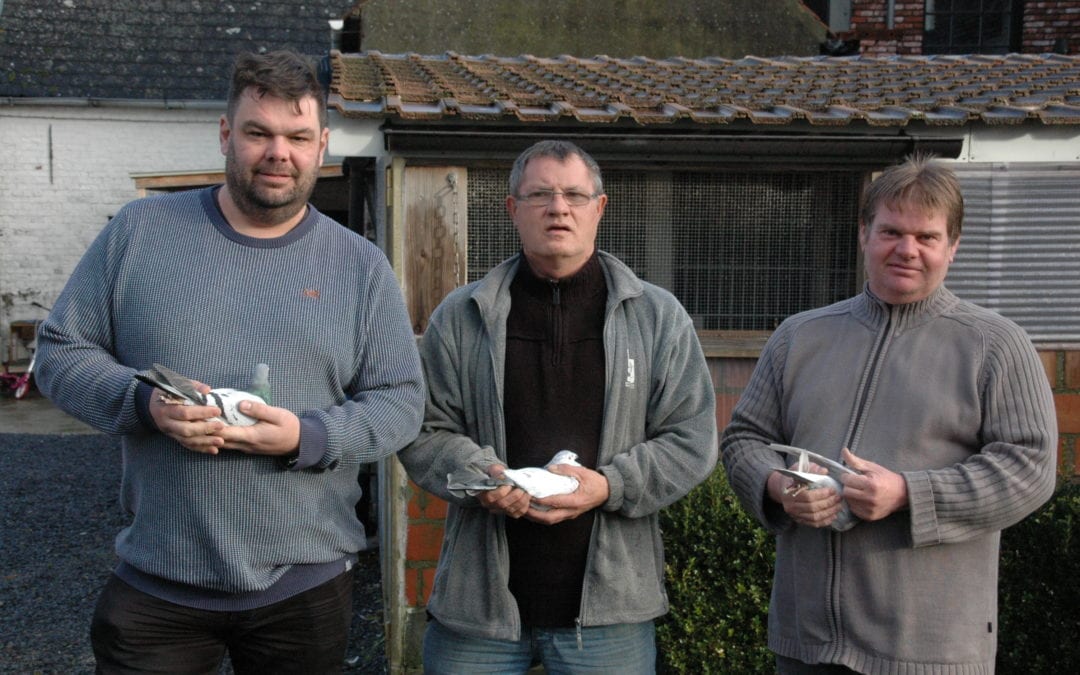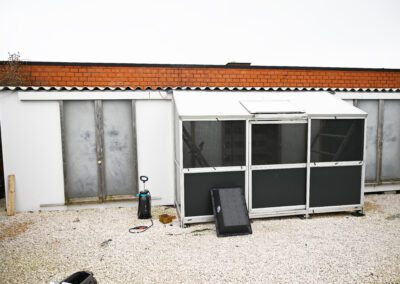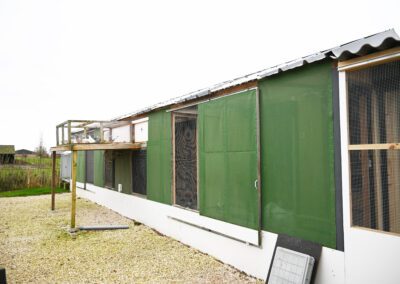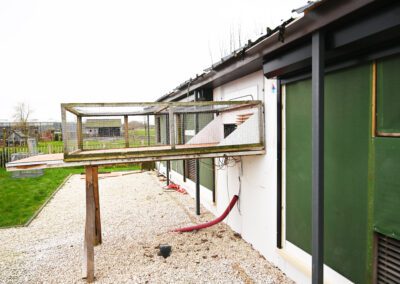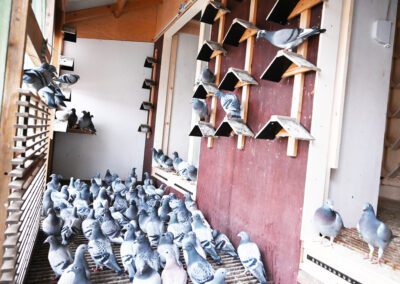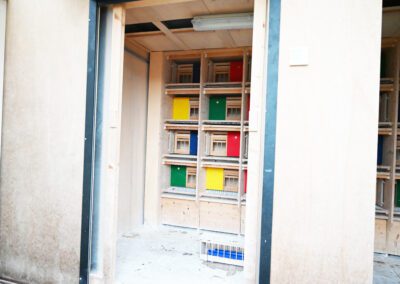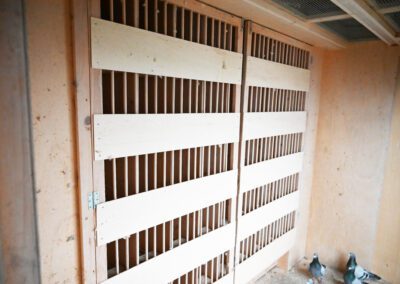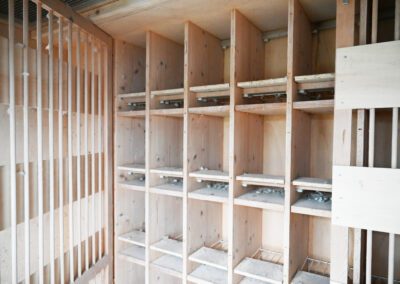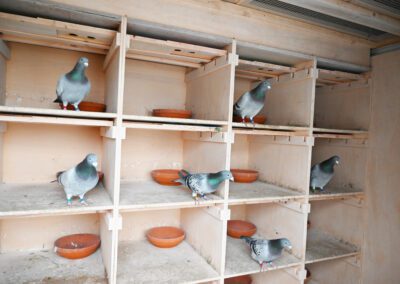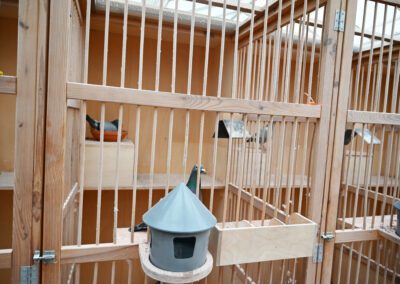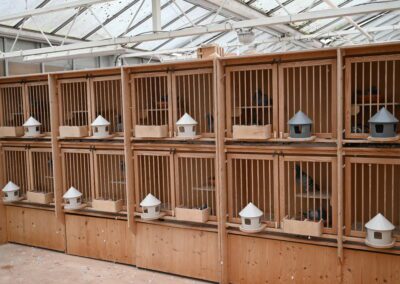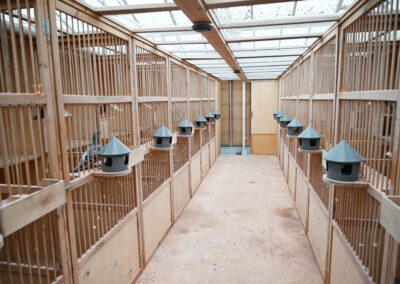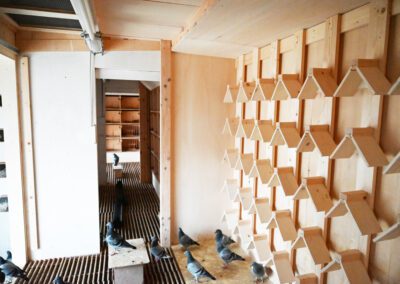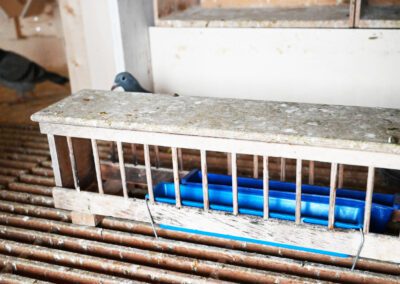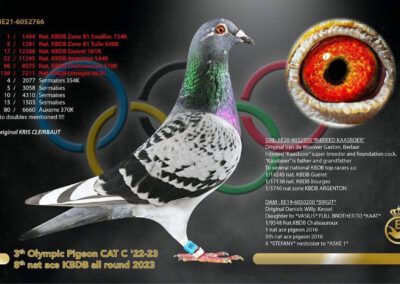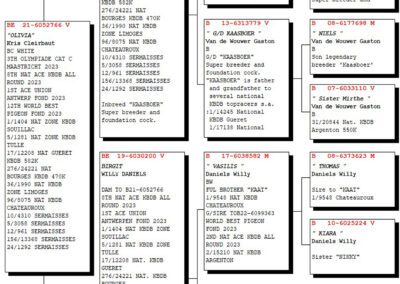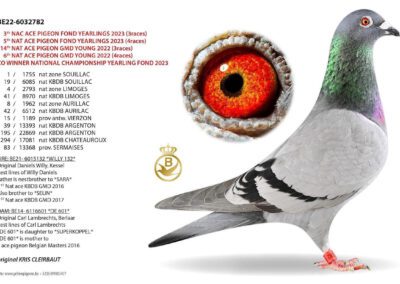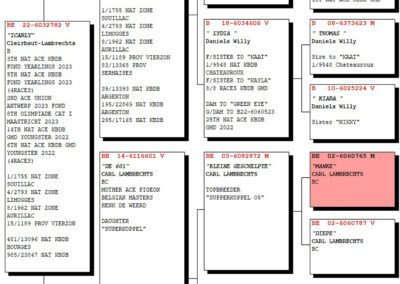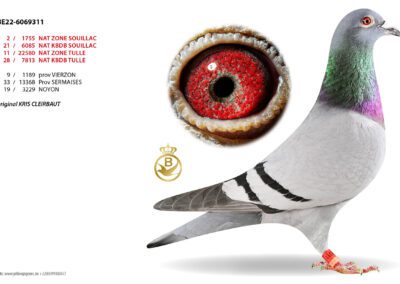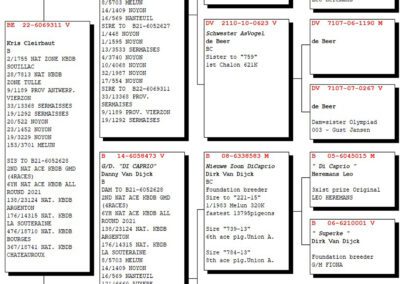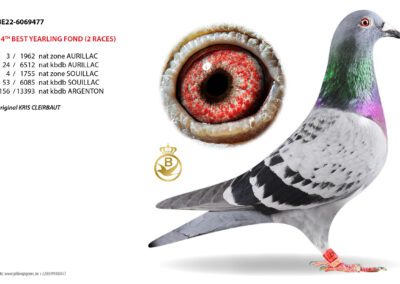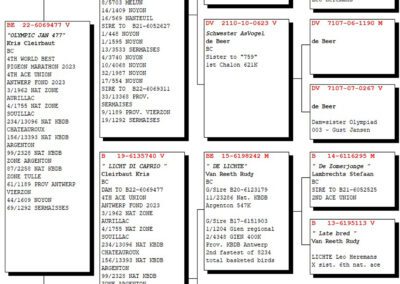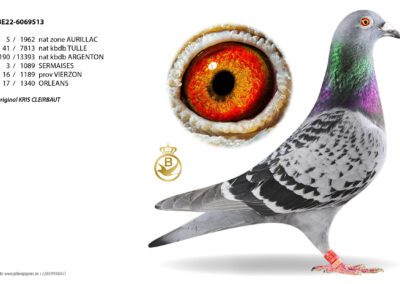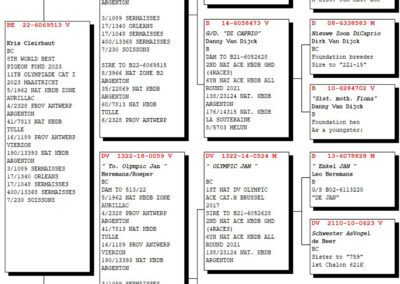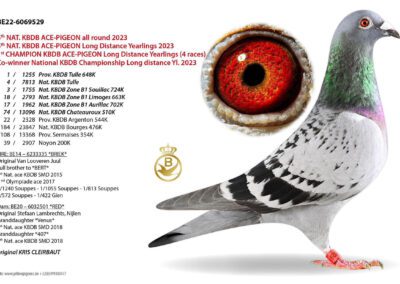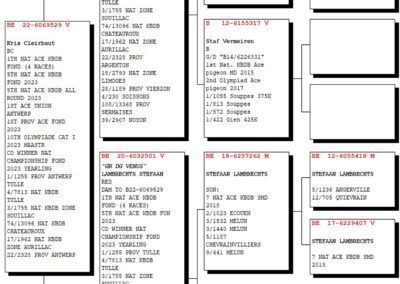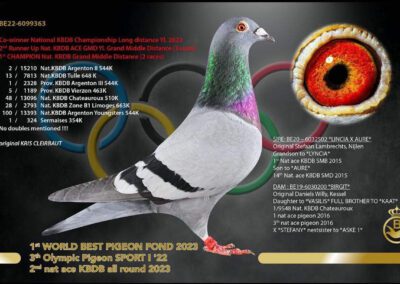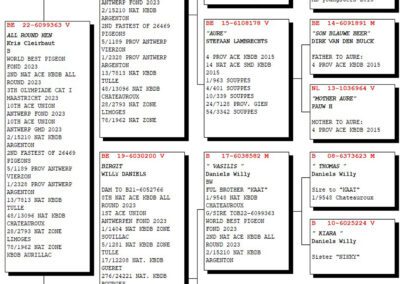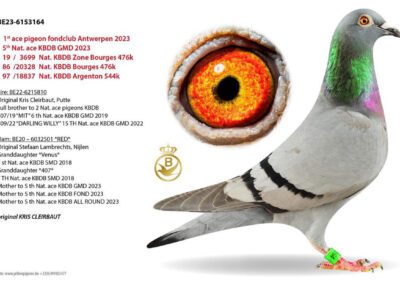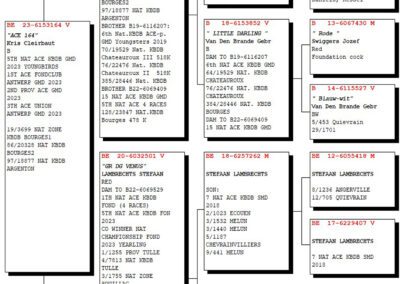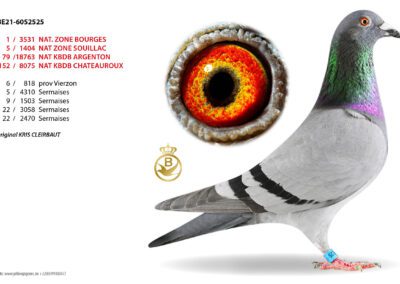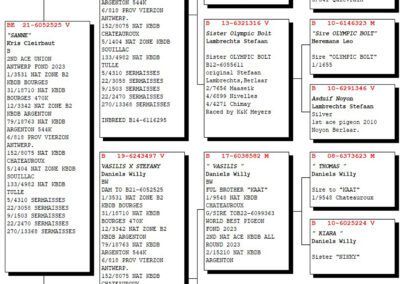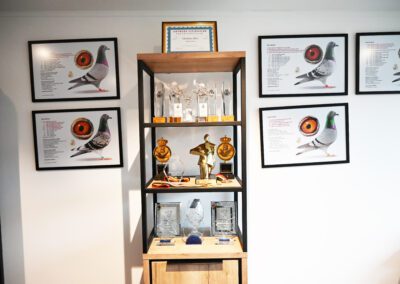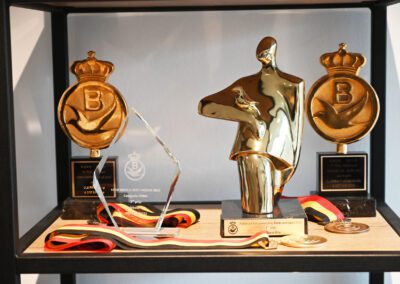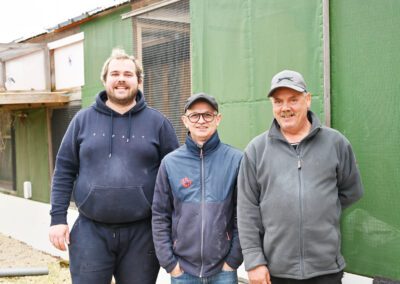TEAM DE RIDDER
1st GENERAL CHAMPION KBDB 2019
Hundelgem: For this report we visited the 1st General Champion of Belgium KBDB 2019. A very difficult competition which is disputed with the 1st nominated bird and this on 17 different races namely 2 races “Marathon old birds” (to choose from the 7 international races), 3 races “Fond old birds” (to choose from the 10 national races), 2 races “yearlings Fond and Marathon” (to choose from the 7 national races), 2 races “great middle distance old” and 2 races “great middle distance yearlings” (to choose from 8 national races), 2 races “great middle distance young birds” (to choose from 4 national races) and 1 race short distance (this with old and yearling birds).
With the following results Team De Ridder became general champion of Belgium KBDB
Noyon yearbirds 5th/212b.
Noyon young 47th/614b.
Chevrainvilliers old 29th/336b.
Chevrainvilliers young 3rd/248b.
Issoudun Nat (z) yearbirds 2nd /2,780b.
Montluçon Nat. (z) yearbirds 5th /3,434b.
Montluçon Nat. (z) old 81st / 2,656b.
Bourges Nat. (z) old 192nd / 6,026b.
Bourges Nat. (z) young 580th / 8,545b.
Chateauroux Nat. (z) young 41st / 7,593b.
Libourne national yearbirds 161st / 4,354b.
Souillac national yearbirds 156th / 4,056b.
Souillac national old 302nd / 3,737b.
Valence wet (z) old 39th / 762b.
Montauban national old 450th / 5,408b.
St. Vincent national old 39th / 2,949b.
Perpignan national old 60th / 3,915b.
We can guarantee you… it is anything but an easy task to score all the points for this championship with your first nominated bird… but Team De Ridder succeeded with great distinction and can more than deserve to be called “general champion of Belgium” for 1 season !
TOGETHER STRONGER
In fact, the start of this team goes back to 1980. Then father Albert De Ridder raced in combination with his brother-in-law. Short distance was their thing and the competitors knew it. Unfortunately, Father Albert passed away in 1988. Sons Dirk and Gerdy took over the pigeon torch until Gerdy married and moved in ’96. The pigeon sport disappeared in the background but during a dark winter evening in 2007 Dirk and brother Geert made plans to make a new start in pigeon sport. They thought “strong together” and with Gunther De Backer even a 3rd fanatic fancier was taken under the arm. The tasks were written down on paper. Geert, half-time maintenance man and enjoying sliding working hours, takes care of the tasks in the morning. Dirk, who has been a postman for 30 years, can be present in the lofts from 14h onwards and Gunther (electrician/inspection technician) takes care of the administrative tasks. In Hundelgem pigeon racing equals playing pigeons and pigeons can be raced from the speed up to and including Barcelona… so De Ridder’s birds are basketed at all distances.
THOUGHTFUL PLANNING
Honestly … when we drove up the driveway of these champions, we expected extensive loft accommodation but that turned out not to be the case. Clearly, they don’t race with the crowd here but try to participate in as many flights as possible on a weekly basis by means of a well-thought-out planning with a small basket. The race team consists of 15 old widowers, 15 yearbird widowers, 5 old hens, 15 yearbird hens, 25 breeding couples and 80 youngsters.
The base of the colony was built with pigeons that can score on all levels. So, they purchased birds by Daniel Van Herzeele (Elene), D’Hondt Germain (Anzegem – strain De Rauw-Sablon), David Vermassen (Gavere), D’Hondt Michel & Filip (Etikhove), Stefan Mertens (Geraardsbergen) and Brothers Van Lierde (Asper). Their best breeding couple is without discussion “Stefan” (B12-4137893 – original Stefan Mertens) x “Kelly” (B15-4080505 – original David Vermassen), they became parents of:
“Toerke” B18-4075060 winner of: 7th Chevrainvilliers 248b. – 10th Noyon 227b. – 12th Noyon 371b. – 14th Noyon 549b. – 33rd Nat (z) Chateauroux 1,104b. – 41th Nat Montluçon 14,104b. – 139th Nat (z) Bourges 5,694b. – 161th Nat. Issoudun 11,465b. – 381th Nat. Bourges 17,969d. – 423rd Nat. Bourges 10,401b.
“Sanne” B16-4042429 winner of: 4th Blois 124b. – 12th Chateauroux 277b. – 18th Chateauroux 199b. – 20th Bourges 326b.
“Hazard” B19-4000022 winner of: 3rd Chevrainvilliers 248b. – 14th Chateauroux 582d.
“Eric” B18-4075061 winner of: 1st Noyon 439b. – 25th Brières 251b. – 23rd Chevrainvilliers 248b. – 573rd Nat (z) Issoudun 2,780b.
RACING HENS
For the ladies, there is no early winter breeding on the program. No… they sit during the whole winter period in a closed aviary where they are served a “resting mixture” once a day and drink tea or Naturamine (vitamins Natural) several days a week. At the end of February, beginning of March, they move to the hen’s loft and can fly out again. “The winter fat has to come off” Dirk says. The hen’s loft is specially constructed so that the ladies have almost no possibility to crawl together. The feed changes from “resting mixture” to “low protein mixture” and depending on the weather conditions is fed.
Mid April the hens are coupled, and the training baskets are removed from the attic. Weather permitting, the hens are tossed as much as possible. When the first hens breed for 7 days, all cocks and all nests are removed, and widowhood is a fact. Via speed and middle-distance races, it goes towards national races. From May onwards, the hens must train twice a day for 45 minutes to 1 hour. If necessary, the flag is raised so that the hens train smoothly from the beginning of the season. Once the season is in full swing and the hens weekly basketed for a 500km race, they only train once a day.
When the first national flight is raced, the hen’s team is divided into 2 groups. One group stays on the 500-km races while the others are prepared at different times in the ideal nest position for a marathon flight. For example, Pau is basketed on 10 days of breeding, on Agen with small babies and the same nest position also applies to Barcelona. If you race pigeons on nest, you must look very carefully at the board and be able to respond to every situation.
WIDOWERS
The 30 widowers are just like the hens in the aviary during the whole winter period. At the beginning of April, they come to their loft and are immediately coupled. They are also allowed to breed for about 7 days before going on widowhood. During this period the cocks also learn a lot. Cocks who know that their hens are waiting at home are better motivated to fly straight home and while doing so, they get to know “the cocks”.
CARE SYSTEM
A similar care system is used for both hens and cocks. On returning home and the day after, a sport mixture is fed. Afterwards the hens switch to Gerry Plus (low protein) to be fed an energy mixture enriched with sweets the last days before basketing. If widowers get an extra week or the marathon kites even 2 weeks extra rest, then a longer period of low-protein mixture is given. Feeding is done completely on feeling, as a basic quantity there is about 30gr feed per pigeon and then it is checked if the pigeons still have much or little appetite. If the feeling of the owner says that they have enough, the feeder is taken away. Only on the day of basketing, the birds can eat as much as they want.
When they return home there are electrolytes together with Naturamine or tea in the drinker. Tuesday evening and Wednesday before basketing the food is moistened with lecitin oil on which Probac Energy or Boost X5 is mixed. Belgasol is mixed in the drinking water. On basketing day, pure water and pure feed are served.
From a medical point of view, the medicine cabinet is preferably kept closed as much as possible. At the end of October all pigeons are treated with Theraprim for 6 days. There is no vaccination. When the racing is brooding in April, they are treated with Tricho Plus for 5 days so that they can start the season free of tricho. Afterwards weekly yellow drops go into the beak. Before departure and after returning home an eye drop (Lysocure) disappears in each eye. Against ornithose, except for 1 day of Soludox per month, nothing is given.
YOUNG BIRDS
“In 2 rounds we breed 80 youngsters” starts Geert’s story “every year we order 100 rings but at the end of the year about 20 remain in the drawer. In the beginning, both rounds are separated, but once they fly well, they are left together. Because the game with the old and yearling pigeons takes up a lot of our time, the game with the youngsters ends up in the background. We don’t race our youngsters according to the system of the sliding door or at widowhood like the real specialists do. No… here the sexes stay together, and it is certainly not forbidden to start a nest. The youngsters train once a day, this together with the marathon hens. And before I forget… when they train, it’s for everyone… so all pigeons, even those who breed or sit on babies, are taken from their nest and must go outside to train around the loft.
The youngsters are darkened from March 21 till June 21. We do not follow the lightning system afterwards. We do put the necessary energy in the training tosses of the youngsters. In about 20 stages, it goes in the direction of 35km.
If all goes well, most of the youngsters go to Bourges national. Last season we were with 40 youngsters at the basket table of this national race and 23 could place their ring number on the national result (prizes 1/4). For the cocks, Bourges is usually the last race of the season. They have gained the necessary experience and can save themselves some energy for next year. The young hens are raced further on the following national races.
SOME TOPPERS
RESULTS 2019
|
vierzon: |
reg |
402 |
25-26-70-114-117 |
(5/11) |
||
|
zon |
7129 |
360-401-1104-1725-1757 |
(5/11) |
|||
|
nat |
20956 |
848-937-…. |
||||
|
Limoges: |
reg |
403 |
25-113-123-133 |
(4/7) |
||
|
nat |
4612 |
457-…. |
||||
|
Valence: |
reg |
72 |
8-9 |
(2/2) |
||
|
prov |
755 |
56-75 |
||||
|
zon |
762 |
39-55 |
||||
|
nat |
7974 |
713-940 |
||||
|
Pau: |
reg |
66 |
5-19 |
(2/2) |
||
|
prov |
564 |
94 |
||||
|
nat |
2797 |
308 |
||||
|
Montauban: |
reg |
145 |
5-14-42 |
(3/4) |
||
|
zon |
1589 |
80-204 |
||||
|
nat |
5408 |
141-450 |
||||
|
Agen YL: |
reg |
40 |
2 |
|||
|
zon |
912 |
36 |
||||
|
nat |
4650 |
140 |
||||
|
Barcelona: |
reg |
129 |
9-35 |
(2/3) |
||
|
prov |
1416 |
124 |
||||
|
nat |
7301 |
635 |
||||
|
Limoges 2 Yl: |
reg |
306 |
40-41-42-77 |
(4/8) |
||
|
zon |
3792 |
516-517-519 |
||||
|
Montlucon O: |
reg |
82 |
5 |
(1/3) |
||
|
zon |
2656 |
81 |
||||
|
nat |
9857 |
426 |
||||
|
Montlucon Yl: |
reg |
149 |
2 |
(1/3) |
||
|
zon |
3434 |
5 |
||||
|
nat |
14104 |
41 |
||||
|
St-Vincent: |
reg |
80 |
2 |
(1/2) |
||
|
prov |
542 |
13 |
||||
|
nat |
2949 |
39 |
||||
|
Marseille: |
reg |
20 |
4-7 |
(2/2) |
||
|
prov |
240 |
25-36 |
||||
|
nat |
2239 |
220-334 |
||||
|
Issoudun O: |
reg |
98 |
12 |
(1/1) |
||
|
zon |
2091 |
85 |
||||
|
Issoudun YL: |
reg |
188 |
1-33-49 |
(3/4) |
||
|
zon |
2780 |
2-340-573 |
||||
|
Libourne YL: |
reg |
72 |
5-16 |
(2/2) |
||
|
prov |
782 |
44-101 |
||||
|
zon |
1297 |
110-242 |
||||
|
nat |
4354 |
161-407 |
||||
|
Narbonne: |
reg |
57 |
9-13 |
(2/2) |
||
|
prov |
814 |
109-156 |
||||
|
nat |
3580 |
395-575 |
||||
|
Perpignan: |
reg |
135 |
4-12-33 |
(3/5) |
||
|
prov |
742 |
24-57-137 |
||||
|
nat |
3915 |
60-205-610 |
||||
|
Bourges Yl: |
reg |
204 |
10-30-59 |
(3/3) |
||
|
zon |
2093 |
57-148-433 |
||||
|
nat |
10401 |
423-1022-2488 |
||||
|
Bourges jong: |
reg |
683 |
3-4-7-41-47-65-66-72-76-86-107 |
21/40 |
||
|
110-117-143-144-157-170-189 |
||||||
|
203-223 |
||||||
|
zon |
8545 |
25-28-39-324-382-…. |
23/40 |
|||
|
nat |
28446 |
94-106-140-… |
23/40 |
|||
Dirk, Geert en Gunther… congratulations with this top tittle!
Stefan Mertens
